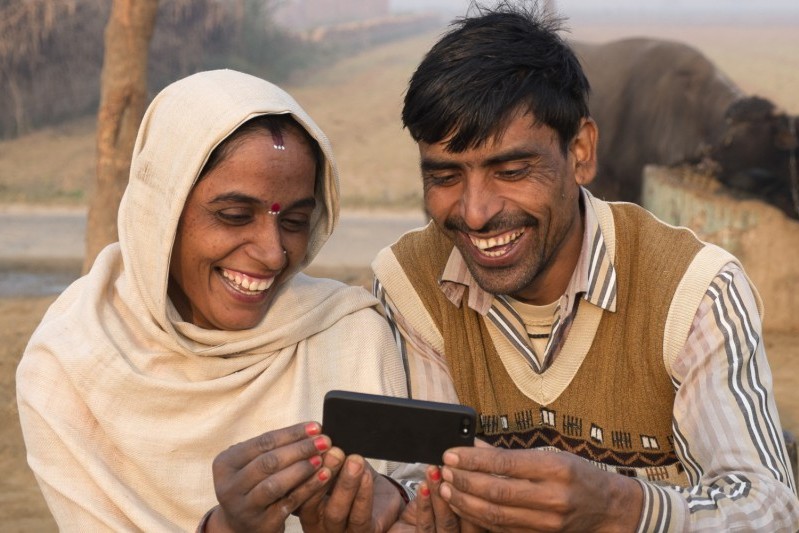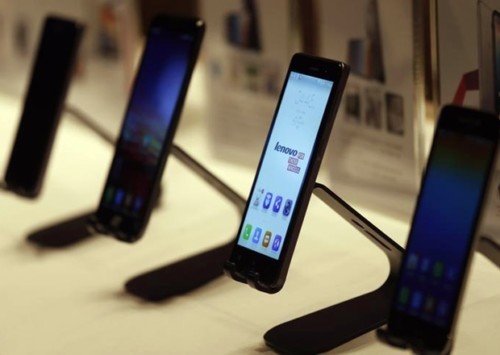Internet wave in India
With the gush in internet penetration in India and with the availability of cheap data, the government needs to find out smart solutions to stop the misuse of internet by building an informed and engaged citizenry.
Two years back Ujwala Debnath (57) struggled to answer a keypad phone. “It was very confusing. I used to panic and forget which one was pressed for receiving and which one was used for disconnecting calls.” However, today Debnath can order saris for herself, is quite an active user of Facebook and can even make video calls. “My grandson gifted me an android phone six months back and taught me how to use it. Since then most of my time is occupied on the phone,” she adds.
Like nearly 500 million people in India, Debnath too is shaping the future of internet in the country. India has seen explosive growth in internet users, stimulated by the initiatives of big tech giants to tap vast new markets with an aim to modernise the country’s infrastructure. The Indian government too has been taking several hard hitting initiatives since the past decade to promote digital literacy and ensuring that internet access is available in every home.
India’s internet users expected to register double digit growth to reach 627 million in 2019, driven by rapid internet growth in rural areas, according to market research agency Kantar IMRB.
“Increased availability of bandwidth, cheap data plans and increased awareness driven by government programmes seem to have rapidly bridged the digital gap between urban and rural India. Consequently, the penetration in rural India has increased from 9 pc in 2015 to 25 pc in 2018,” the report added.
India has proved to be a critical market for Facebook’s messaging app WhatsApp, as it has more than 200 million users here, more than any other country. Similarly, Google has helped set up free WiFi services at over 400 train stations across India, and also runs a digital literacy programme to teach rural Indian women how to use the internet.
Cheap data in India
According to a recent BBC report, India has the cheapest mobile broadband prices in the world. The BBC report, citing a UK-based price comparison site, said that one gigabyte (GB) of mobile data cost USD 0.26 in India (EUR 0.20), compared with USD 12.37 in the US, USD 6.66 in the UK, and a global average of USD 8.53.
Normally users in India pay less than USD 3 a month for unlimited free calls. With that they get 42GB of 4G data, at 1.5GB a day, which they use for viewing videos. The Indian government is working to improve the online infrastructure and internet connectivity through the ‘Digital India’ programme with a vision to transform the country into a digitally-empowered society and knowledge economy.
Earlier, India’s internet action lay centred in its metros. However, now internet penetration has reached even smaller cities and rural places primarily via mobile data transmitted over wireless spectrum. In 2014, the cost of one GB of mobile data was INR 270. Now, it is INR 10 per GB. As a result, mobile data consumption has soared. In late-2014, an average user on Airtel’s network (India’s largest telecom operator back then) used 622 megabytes (MB) of data in a month. By late-2018, the number of users had tripled, but, despite a broader base, average data usage stood at 10 GB a month.
According to a report titled ‘Unlocking Digital for Bharat’, published jointly by Bain & Co., Google, and Omidyar Network, India had 390 million active internet users in 2017, the second highest user base in the world after China with 733 million. Even at this level, internet penetration in India stood at a mere 28 pc, compared to 53 pc in China, signalling the future runway for growth available in the country. The internet user base in the country has doubled since 2014, and the same report suggests that the velocity of addition of internet users in India, at 40 million per year, is the highest in the world.
The Jio effect
Reliance Jio, the brainchild of India’s richest man Mukesh Ambani, changed the story of internet access in India. According to Mary Meeker’s Internet Trends Report 2019, over half of the world’s population has access to the internet now, with a majority of users (about 53 pc) coming from the Asia-Pacific region.
Out of the 3.8 billion internet users in the world today, India now accounts for 12 pc of the world’s internet users, second only to China (21 pc). USA is third at eight percent, says the Meeker report.
This growth has largely been driven by telecom operator Reliance Jio, which Meeker pointed out, had grown 2X in a year reaching 307 million subscribers.
Reliance Jio has been offering free voice calling and cheap data plans which have helped grow data usage by two-fold in one year. Jio’s annual data usage was between 17-18 exabytes (17-18 billion GB) in 2018, which is almost two times growth from 9 exabytes data usage in FY 2017. The number of Reliance offline retail stores are reported to be about 11,000, while the company is planning to use its more than 5,100 Jio point stores located in 5,000 cities and towns as delivery and collection points for its e-commerce venture. With this, the company is expected to expand its direct reach to 95 pc of India’s population.
Within a span of just two years, Jio has become the third largest telecom operator in India, with 280 million subscribers by December 2018. According to India’s telecom regulator TRAI, India had more than 500 million mobile broadband subscriptions at the end of December 2018, but just 18 million wired broadband subscriptions. Of the 1.17 billion mobile subscriptions in the country, 55 pc of them are in urban areas. The big jump in broadband usage, all of it on mobiles, came mostly from Jio.
Economic boost
According to the report by Bain, Google and Omidyar it is expected that over 500 million Indians to either start using the internet for the first time or make an online transaction for the first time and pegs the economic opportunity from these potential consumers at USD 50 billion.
The internet economy in India is expected to exceed USD 215 billion by 2020, up from over USD 100 billion in 2017, led by growth in financial services and e-commerce.
Three areas in which India’s digital push has shown clear results already are e-commerce, fintech, and online video streaming. According to a joint report by the Internet and Mobile Association of India (IAMAI) and market research firm Kantar IMRB, the market for digital commerce in India grew at a compound annual growth rate (CAGR) of 34 pc between 2011 and 2017 to INR 2040 billion.
Amazon, the e-commerce platform that entered India in 2013 has committed as much as USD 5 billion to capture a significant share of one of the world’s fastest growing consumer internet markets. According to a Citi Research report, Amazon in India is estimated to be worth USD 16 billion. The May 2017 report stated that Amazon had achieved a gross merchandise value (GMV), or total value of goods sold, of USD 5 billion in India, second to home-grown Flipkart, which had a GMV of USD 7.5 billion.
Facebook (FB) wants to set up 20,000 hotspots through its Express WiFi initiative that connects users for about INR 10 (USD 0.14) a day. The government has a plan to install 250,000 hotspots in villages across India.
Foreign capital accounts for 80-90 pc of all investments in India’s startups, according to industry estimates. Large investors such as Softbank, which has invested USD 2 billion in India and plans to add USD 2-3 billion more, provide key (and rarely available) later stage capital to the ecosystem.
A recent IDFC Securities Research report pegs mobile wallets to be a USD 120 billion industry in the next five years, digital payments to be a USD 500 billion opportunity, and fintech-based financing to be a USD 1 trillion business over the same period.
Doing more harm than good
Even though the internet is bringing business in the country it has its fair share of dark side too. Meeker warned that it will get tougher in the years to come. Removing offensive and violent content from platforms would be a continuous challenge. Also, social media would lead to increased political polarisation and divisiveness.
Almost half of the internet users have social media accounts, but most of them don’t know how to do online banking. Bengaluru-based RedSeer Consulting said in a report that, “(Social media) is the step people first get involved with since it’s more of a habitual thing. The difference between stage one and two is slight, but there is a section of people on Facebook and WhatsApp that doesn’t use e-mails.”
Banking transactions are low as nearly one in five Indians are still unbanked, and those who do have accounts are wary of online fraud. Pictures and videos are now the default mode of communication. Short-form video stories on the “Facebook platform” (Facebook Stories, Instagram Stories and WhatsApp Status) now have 1.5 billion daily active users globally. Even on Twitter, more than 50 pc of impressions generated involve posts with images, videos, GIFs, etc. Earlier, Twitter was primarily a text-only platform earlier.
According to a 2017 report by IAMAI and IMRB International in 2017, the overall internet penetration in India is currently pegged at 31 pc. While India is still to conduct a national study on internet addiction, an extensive study funded by the Indian Council of Medical Research and conducted by the country’s premier mental health facility, National Institute of Mental Health and Neurosciences and titled ‘Behavioral addiction in the community: an exploration’, gives a glimpse into the problem. Conducted in 2012 over 15 months, with a sample size of 2,755 respondents in Bengaluru, it revealed that 4.1 pc of the respondents were addicted to their cell phones and that mood disturbance and anxiety showed a “positive correlation” with smartphone and internet addiction.
Besides social media, online gaming continued to woo audiences. There are about 2.4 billion interactive game players in the world right now. That is an increase of six percent in a year.
A recent report compiled by U.S-based cloud services firm Limelight Networks reveals that 24.2 pc of Indian gamers have skipped work to play. This figure is higher than it is for French, German, Italian, Japanese, Singaporean, South Korean, British and American gamers. Some 52 pc of surveyed Indian gamers admitted to playing during work hours — again the highest figure globally.
Not just gaming but internet has its own way of manipulating the electoral process, not to forget the Cambridge Analytica case. There were also allegations in India that political parties have collected personal data to classify voters on the basis of their location, religion, caste, age, socioeconomic status etc to add them to respective chat groups.
The rate at which technology is evolving and enabling data to be harnessed in different ways in India is quite overwhelming. However, with the gush in internet penetration in India and with the availability of cheap data, people choose to rely on online platforms for daily news. In the absence of digital literacy people are swayed by what they see online. The government needs to find out smart solutions to stop the misuse of internet by building an informed and engaged citizenry.













